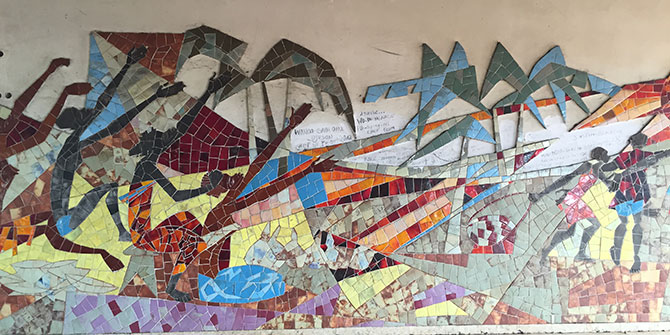Zaheera Jinnah shares ongoing research being done on artisanal gold mining and its connections to migration, informality and social exclusion in South Africa.
This post is part of our series African Perspectives on Migration looking at the theme of Intra-Africa migration.
On the western periphery of Johannesburg, with the famous skyline of the city silhouetted in the early morning sun, Bongani is beginning another day of work. Here atop and surrounded by the mine dumps that founded the city more than a century ago, he is one of scores of people mining for gold. His task is complex; to locate gold bearing ores underground in disused, abandoned mines and bring these to the surface using makeshift tools, where they can be refined and processed further before gold is extracted and sold on to middleman. Bongani and those like him are known to the outside world as zamazama, literally translated to mean “we are trying” but whose work and profile has become synonymous with criminality, gangsters, illegality, and irregular immigration. Bongani and others identify themselves identify as miners, or businessmen, ordinary people trying to make a living in a harsh economic climate.

Photography by Alexia Webster and Janet Munakamwe 13/09/2014
The reality of informal mining is somewhere between these two dichotomies; a reality rooted in historical legacies of unequal access to mineral wealth, of a deeply exploitative migrant labour system, and a contemporary reality of poverty and unemployment in one of Africa’s richest cities.
The mining sector in South Africa plays a critical role in the country and region’s economy. Currently, mining accounts for 484,000 direct jobs with a further 800,000 estimated indirectly, and contributes to around seven per cent of the country’s Gross Domestic Product (GDP). Historically gold mining has been a significant source of employment and livelihoods to thousands of regional households. Throughout the twentieth century, at least 40% of workers employed on South African mines originated from outside the country[1].
Although these statistics are significant, there is a deeper narrative at play here. A parallel and at times intersecting economy of informal artisanal mining has existed for decades across the world, yet little attention in South Africa has been paid to the historical and global connections of artisanal mining. Moreover, little attempt has been made to situate it within its contemporary economic and political context. Instead, the overarching discourse on informal mining in South Africa has been to criminalise it, with little understanding of its role as a source of livelihoods and its relation to social exclusion.
In recent years South Africa has faced numerous challenges that have paved the path into informal mining for people like Bongani and others; slow economic growth, an official unemployment rate of 25% and exceedingly high urbanisation rates (30% of Johannesburg’s residents are domestic migrants). For international migrants such as Bongani, this is compounded by an immigration regime that is both rigid and corrupt, and a sharp decline of 20% in formal employment among regional workers in the industrial mining sector[2]. In this context informal mining is a critical if desperate strategy for survival among poor households within and beyond South Africa.
For miners the work is physically dangerous and legally risky. Aside from being exposed to mercury, and being vulnerable to rock falls underground, they also face severe discrimination harassment and arbitrary arrest and detention from police who are keen to stop informal mining. Raids, confiscation of goods and mass arrests are common at mine dumps. Often charges are dropped or miners are released on warning or after paying a fine for trespassing; more commonly miners, especially international migrants, are released once they bribe police. Yet many persist lured by the prospect of making better money in the sector than in other informal markets. For some like Bongani whose father was also a miner, it is the only type of work they know.
What emerges beneath the surface of Johannesburg’s informal gold mining sector is twofold: first the order, dangers and response associated with informal mining in South Africa are symptoms of broader violence, precarity and informality that characterise socially-excluded spaces in South Africa’s urban peripheries. Sixteen percent of the labour force is employed in the informal sector, and a further 8% work in private households often as informally employed –and poorly paid- domestic workers and gardeners. Moreover, street traders, sex workers, and others carving a space in the city face regular police harassment, and resort to bribery to continue working.
Second, a labour migration policy framework and a corresponding popular and political discourse on xenophobia are key components of processes that exclude, marginalise and criminalise regional cross-border migrants. What this translates into is a context in which Bongani and others face severe and multiple obstacles in earning a living.
Zaheera Jinnah is a researcher at University of the Witwatersrand African Centre for Migration & Society.
Read more articles from our series, African Perspectives on Migration
The views expressed in this post are those of the authors and in no way reflect those of the Africa at LSE blog or the London School of Economics and Political Science.
[1] Budlender (2014). Migration and employment in South Africa: Analysis of the migration module in the Quarterly Labour Force Survey, third quarter 2012. MiWORC Report. Johannesburg: African Centre for Migration & Society (ACMS), University of the Witwatersrand.






2 Comments